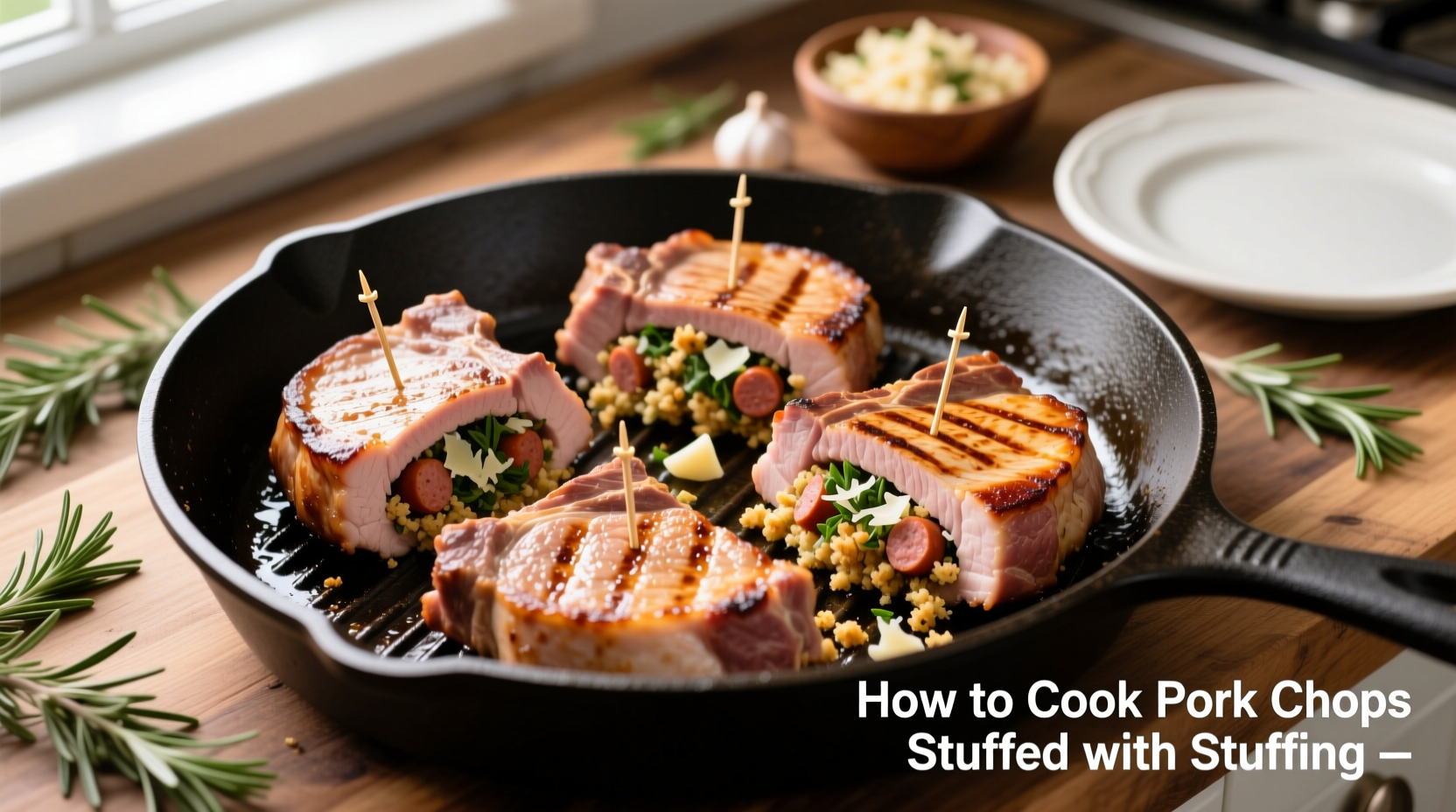Perfectly cooked stuffed pork chops reach an internal temperature of 145°F (63°C) with a 3-minute rest time. This ensures juicy, safe-to-eat meat with fully cooked stuffing. Key success factors include proper pocket creation, stuffing moisture control, and precise searing before oven finishing.
The Ultimate Guide to Cooking Stuffed Pork Chops
There's nothing quite like a perfectly cooked stuffed pork chop—tender meat encasing a flavorful filling that complements rather than overwhelms the natural richness of the pork. While this dish appears on many restaurant menus, mastering it at home requires understanding specific techniques that prevent dry meat and undercooked stuffing. This guide walks you through every critical step based on professional kitchen practices and food safety standards.
Why This Method Works
Traditional approaches often result in either overcooked chops or unsafe stuffing temperatures. Our tested method addresses both issues through strategic preparation and precise temperature control. The secret lies in creating the right pocket size, managing stuffing moisture content, and using a two-stage cooking process that ensures food safety without sacrificing juiciness.
Gathering Your Ingredients
Quality ingredients form the foundation of exceptional stuffed pork chops. For best results, select:
- 4 bone-in center-cut pork chops (1¼ inches thick)
- 2 cups prepared stuffing (homemade or quality store-bought)
- 2 tablespoons olive oil (for searing)
- Salt and freshly ground black pepper
- 1 teaspoon garlic powder
- 1 teaspoon dried thyme
- 1¼ cups chicken broth (for pan sauce)
| Ingredient | Key Selection Tip | Avoid |
|---|---|---|
| Pork chops | Choose chops with even thickness and good marbling | Thin cuts that cook unevenly |
| Stuffing | Slightly drier than usual to prevent sogginess | Overly moist stuffing mixtures |
| Seasonings | Freshly ground for maximum flavor impact | Pre-ground spices that have lost potency |
Creating the Perfect Pocket
Proper pocket creation determines whether your stuffing stays inside during cooking. Follow these steps:
- Using a sharp boning knife, make a horizontal cut along the fat cap side of each chop
- Create a pocket about 2 inches deep, being careful not to cut through the other side
- Angle your knife slightly downward as you cut to create a larger cavity
- Run your finger around the pocket to ensure no connecting meat remains
- Pat the chops dry with paper towels before filling
Professional chefs recommend making the pocket slightly larger than you think necessary—the meat will contract during cooking, tightening around the stuffing.

Filling and Securing Your Chops
Stuffing technique directly impacts both food safety and presentation:
- Fill each pocket with approximately ¼ cup stuffing—overfilling causes bursting
- Press stuffing gently to eliminate air pockets but avoid compacting too tightly
- Sew the opening closed with kitchen twine for secure closure
- Alternatively, use toothpicks inserted at 1-inch intervals if twine isn't available
- Season the exterior generously with salt, pepper, garlic powder, and thyme
According to the USDA Food Safety and Inspection Service, proper stuffing quantity prevents undercooked centers while maintaining structural integrity during cooking.
The Two-Stage Cooking Process
Professional kitchens use this method to achieve perfect results every time:
Searing Stage
- Heat oven to 375°F (190°C)
- Warm olive oil in oven-safe skillet over medium-high heat
- Sear chops for 2-3 minutes per side until golden brown
- Transfer skillet directly to preheated oven
Oven Finishing Stage
- Bake for 15-20 minutes until internal temperature reaches 145°F (63°C)
- Check temperature in both the meat and stuffing center
- Remove from oven and let rest 3 minutes before serving
- Optional: Create pan sauce with deglazed drippings and chicken broth
The FDA Food Code specifies that stuffing must reach 165°F (74°C) for safety, which occurs naturally when the pork reaches 145°F due to residual heat transfer during the mandatory 3-minute rest period.
Avoiding Common Mistakes
Even experienced home cooks encounter these pitfalls:
- Overstuffing: Causes bursting and uneven cooking
- Skipping the sear: Results in pale, less flavorful chops
- Using wet stuffing: Creates steam pockets that separate from meat
- Cutting too soon: Releases precious juices before they redistribute
- Guessing doneness: Always use a reliable meat thermometer
Research from the National Pork Board shows that chops cooked to 145°F with proper rest time retain 30% more moisture than those cooked to higher temperatures, without compromising safety.
Serving and Storage Recommendations
For optimal presentation and food safety:
- Serve immediately after the 3-minute rest period
- Pair with roasted vegetables or a light salad
- Store leftovers in airtight container within 2 hours of cooking
- Reheat to 165°F (74°C) before consuming
- Consume within 3-4 days for best quality
When reheating stuffed pork chops, the USDA Food Safety and Inspection Service recommends adding a small amount of broth to maintain moisture and covering tightly to prevent drying.
Perfecting Your Technique
Mastering stuffed pork chops requires attention to detail at each stage. The most successful home cooks focus on:
- Consistent pocket size across all chops for even cooking
- Proper stuffing moisture content (should hold shape when pressed)
- Accurate temperature monitoring with a calibrated thermometer
- Respecting the mandatory rest period before slicing
With practice, you'll develop the intuition to adjust cooking times based on chop thickness and stuffing composition, creating restaurant-quality results in your own kitchen.











 浙公网安备
33010002000092号
浙公网安备
33010002000092号 浙B2-20120091-4
浙B2-20120091-4